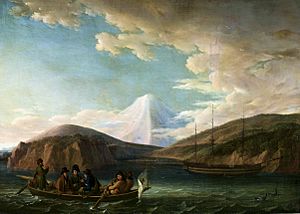Adam Johann von Krusenstern facts for kids
Quick facts for kids
Adam Johann von Krusenstern
|
|
|---|---|
 |
|
| Native name |
Ива́н Фёдорович Крузенште́рн
|
| Born | 10 October 1770 Haggud Manor () Haggud, Harrien County, Governorate of Estonia, Russian Empire (in present-day Hagudi, Rapla County, Estonia) |
| Died | 12 August 1846 (aged 75) Kiltsi Manor, Gilsenhof, Wierland County, Governorate of Estonia, Russian Empire (in present-day Kiltsi, Lääne-Viru County, Estonia) |
| Allegiance | Russian |
| Service/ |
Navy |
| Rank | Admiral |
| Commands held | Nadezhda |
| Awards | Pour le Mérite (civil class) |
Adam Johann von Krusenstern (born October 10, 1770 – died August 12, 1846) was a famous Russian admiral and explorer. He is best known for leading the very first Russian journey around the world, also known as a circumnavigation of the globe. This amazing trip helped Russia explore new trade routes and learn more about the world.
Contents
Life
Krusenstern was born in Hagudi, a place in what is now Estonia. At that time, it was part of the Russian Empire. His family was Baltic German, meaning they were Germans who lived in the Baltic region.
Early Career
In 1787, Krusenstern joined the Russian Imperial Navy. He served in a war against Sweden. Later, from 1793 to 1799, he worked with the Royal Navy of Britain. During this time, he traveled to places like America, India, and China. These travels gave him a lot of experience at sea.
Krusenstern believed it would be very helpful for Russia to have a direct sea route to China. This route would go around Cape Horn (at the tip of South America) and the Cape of Good Hope (at the tip of South Africa). He wrote a paper explaining his ideas.
Tsar Alexander I of Russia was impressed. He chose Krusenstern to lead a big expedition to the Far East coast of Asia. The main goal was to develop the fur trade with Russian America (which is now Alaska). They also wanted to start trade with China and Japan, make trade easier in South America, and explore the coast of California for a possible new colony.
The Journey Begins
The expedition had two ships: the Nadezhda (meaning Hope), commanded by Krusenstern himself, and the Neva, led by Captain-Lieutenant Yuri F. Lisianski. They set sail from Kronstadt in August 1803.
They sailed around Cape Horn at the southern tip of South America. Then, they reached the northern Pacific Ocean. After exploring and trading, they returned by sailing around the Cape of Good Hope in South Africa. Krusenstern arrived back in Kronstadt in August 1806. Both seafarers created detailed maps and kept careful records of their long voyages.
After the Voyage
When he returned, Krusenstern wrote a detailed report about his journey. It was called "Journey around the World in the Years 1803, 1804, 1805, and 1806" in German. It was first published in 1810 in Saint Petersburg. Later, it was translated into English and many other languages, making his discoveries known worldwide. He also published a scientific work, including an atlas of the Pacific Ocean, in 1827.
Krusenstern's discoveries were very important for geography. His work earned him an honorary membership in the Russian Academy of Sciences. He also became a member of the Royal Swedish Academy of Sciences and the American Philosophical Society.
Krusenstern later became the director of a Russian naval school, where he did a lot of good work. He also helped improve compasses on ships to make them more accurate. He became an admiral in 1841 and received an important award called the Pour le Mérite in 1842. He passed away in 1846 at Kiltsi Manor, an Estonian manor he had bought. He was buried in the Tallinn Cathedral.
Legacy
Many things are named after Adam Johann von Krusenstern, honoring his important contributions to exploration and naval science.
Ships and Places
- The Russian training tall ship Kruzenshtern is named after him. In 2005–2006, this ship even retraced his original route around the globe to celebrate the 200th anniversary of his circumnavigation.
- Another ship, the Russian icebreaker Ivan Kruzenshtern, also carries his name.
- An Aeroflot Airbus 320 VP-BKC is named after him.
- A crater on the Moon is called Krusenstern.
- There is Krusenstern Island in the Bering Strait.
- A small group of islands in the Kara Sea are called Krusenstern Islands.
- Cape Krusenstern in Northwest Alaska is a very important archaeological site.
Other Mentions
In Russia, a fictional steamship called Admiral Ivan Fyodorovich Kruzenshtern appears in the popular Prostokvashino animated films. This name is often used in a famous saying.
Krusenstern also played a role in naming the Cook Islands in the South Pacific. These islands were previously known as the Hervey Islands. In 1835, Krusenstern changed their name to honor Captain Cook. He recorded this new name in his Atlas of the Pacific Ocean, published between 1824 and 1835.
See also
 In Spanish: Adam Johann von Krusenstern para niños
In Spanish: Adam Johann von Krusenstern para niños



